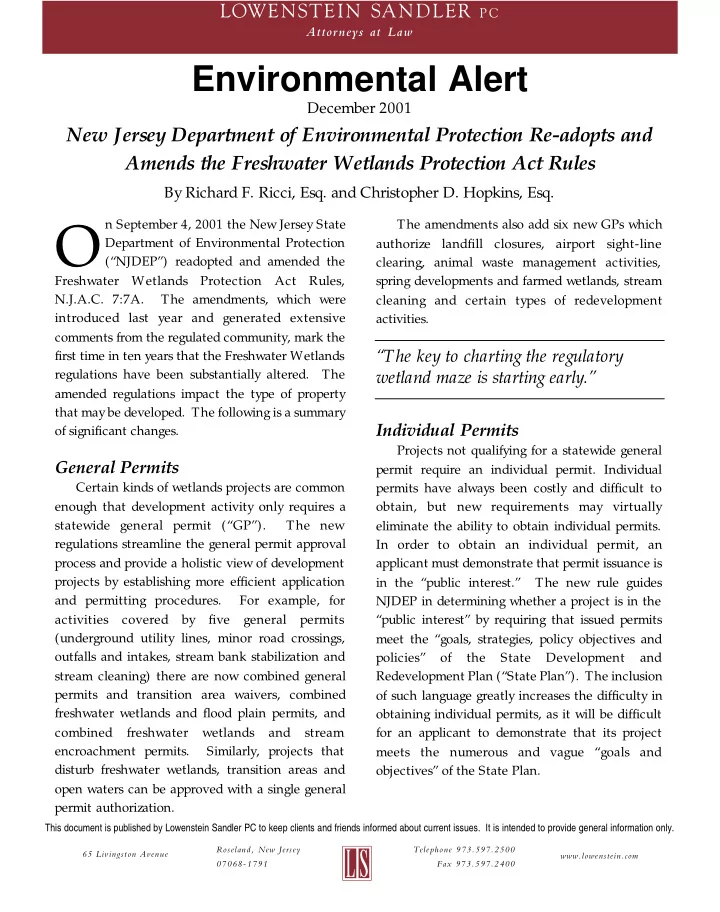

G Environmental Alert December 2001 New Jersey Department of Environmental Protection Re-adopts and Amends the Freshwater Wetlands Protection Act Rules By Richard F. Ricci, Esq. and Christopher D. Hopkins, Esq. n September 4, 2001 the New Jersey State The amendments also add six new GPs which O Department of Environmental Protection authorize landfill closures, airport sight-line (“NJDEP”) readopted and amended the clearing, animal waste management activities, Freshwater Wetlands Protection Act Rules, spring developments and farmed wetlands, stream N.J.A.C. 7:7A. The amendments, which were cleaning and certain types of redevelopment introduced last year and generated extensive activities. comments from the regulated community, mark the “The key to charting the regulatory first time in ten years that the Freshwater Wetlands regulations have been substantially altered. The wetland maze is starting early.” amended regulations impact the type of property that may be developed. The following is a summary Individual Permits of significant changes. Projects not qualifying for a statewide general General Permits permit require an individual permit. Individual Certain kinds of wetlands projects are common permits have always been costly and difficult to enough that development activity only requires a obtain, but new requirements may virtually statewide general permit (“GP”). The new eliminate the ability to obtain individual permits. regulations streamline the general permit approval In order to obtain an individual permit, an process and provide a holistic view of development applicant must demonstrate that permit issuance is projects by establishing more efficient application in the “public interest.” The new rule guides and permitting procedures. For example, for NJDEP in determining whether a project is in the activities covered by five general permits “public interest” by requiring that issued permits (underground utility lines, minor road crossings, meet the “goals, strategies, policy objectives and outfalls and intakes, stream bank stabilization and policies” of the State Development and stream cleaning) there are now combined general Redevelopment Plan (“State Plan”). The inclusion permits and transition area waivers, combined of such language greatly increases the difficulty in freshwater wetlands and flood plain permits, and obtaining individual permits, as it will be difficult combined freshwater wetlands and stream for an applicant to demonstrate that its project encroachment permits. Similarly, projects that meets the numerous and vague “goals and disturb freshwater wetlands, transition areas and objectives” of the State Plan. open waters can be approved with a single general permit authorization. This document is published by Lowenstein Sandler PC to keep clients and friends informed about current issues. It is intended to provide general information only. Roseland, New Jersey Telephone 973.597.2500 L 65 Livingston Avenue www.lowenstein.com 07068-1791 Fax 973.597.2400
G Permit Extensions Residential Construction The amendments allow one five year The new rule broadens the definition of extension to any kind of permit/ waiver, if the “residential development project” to include an project and site conditions have not changed. additional 20 foot area surrounding a house. Thus, Thus, the new regulations may help developers construction of new homes that immediately abut with approved projects that are delayed by third transition areas are subject to additional party problems or local approvals, as long as regulation, as a “buffer on a buffer” is created. The projects are not expanded and other applicable goal is to prevent regulated and prohibited requirements are not by passed. activities, that inevitably happen within 20 feet of construction and use of a house, from taking place Redevelopment in transition areas or wetlands. However, the net The new regulations facilitate redevelopment effect of the regulation is to decrease the amount in degraded wetlands on former industrial of land available for residential construction in commercial developed properties (previously areas that contain wetlands. If an applicant disturbed sites). GP No. 27 authorizes an extra wishes, they can fence and deed restrict the acre of disturbance (in addition to other GP regulated area and demonstrate how they will use disturbances) as an incentive to encourage the house without encroaching upon transition redevelopment. To qualify, activities must be in areas. an area listed by the Brownfields Redevelopment Task Force; subject to a redevelopment Stricter requirements are also imposed for agreement under Brownfields law; or in an paving around wetlands. The new rule provides environmental opportunity zone. that stormwater must be treated when general permit activity would result in one-quarter acre or In addition, the new regulations expand more of impervious surface that will generate redevelopment transition area waivers. A storm water. This requirement to treat and transition area (sometimes called a buffer) is a perhaps monitor storm water can be potentially strip of land bordering the wetlands. The width costly and burdensome. of the transition area may vary from 150 feet down to nothing, depending on the resource Letters of Interpretation value of the particular wetland. If a developer Prior to development, developers must know wishes to pursue activities within a transition whether there are wetland issues associated with a area, he or she must obtain a transition area project. The method for obtaining this waiver. Under the old regulations, redevelopment information historically has been a request for a transition area waivers were only granted if the letter of interpretation (“LOI”) from NJDEP. The transition area was paved. The new rule allows new regulations provide that when seasonal an applicant to receive a transition area waiver conditions make resource classification of a for an area that is “significantly disturbed so that wetland difficult to determine, the applicant has it is not functioning as a transition area...” Thus, the option of accepting a quick LOI with an redevelopment is allowed where the transition automatic (and more heavily regulated) area is significantly degraded, but not paved, and exceptional resource value classification, or wait a developer’s acreage of disturbance at a site is until a definite resource classification can be made. increased.
Recommend
More recommend